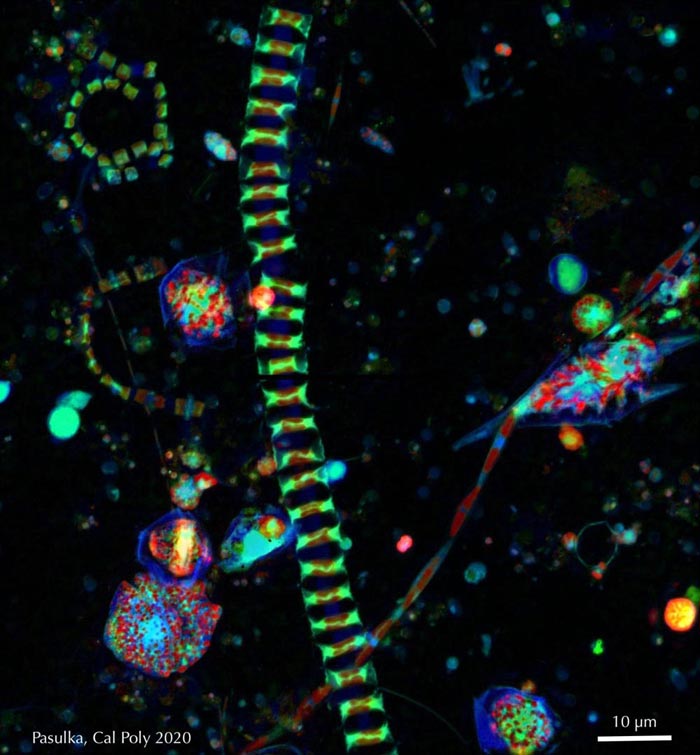Climate variations may impact the base of the food web along the California coast

A fluorescence microscopy image of phytoplankton including chain-forming diatoms and many large dinoflagellates. The different colors indicate different components of the cells including the cell's cytoplasm (green), nuclear material (blue) and chlorophyll pigments (red). The phytoplankton are magnified 1,000 times their actual size. Credit: Alexis Pasulka
In a recent study published in Marine Ecology Progress Series, researchers at California Polytechnic State University revealed that in addition to seasonal changes in winds and ocean temperatures, natural climate cycles greatly influenced the base of the food web at the Cal Poly Pier in San Luis Obispo Bay, an embayment located in Central California in the California Current Large Marine Ecosystem. Like seasons that drive recurring changes in ocean and atmospheric patterns every year, natural climate cycles drive rhythmic changes in these patterns over longer cycles.
The most commonly known natural climate cycle is the El Niño-Southern Oscillation (ENSO), which alters ocean and atmospheric weather patterns over the equatorial Pacific every three to eight years, with cascading effects on global weather patterns. However, along the California coast, other climate cycles such as the Pacific Decadal Oscillation (PDO) and North Pacific Gyre Oscillation (NPGO) can influence local ecosystems on cycles of a few years to a few decades. The study found that while local changes in temperature and nutrients influenced the overall community of phytoplankton that was present in San Luis Obispo Bay throughout the year, the state of these long-term climate cycles, i.e., the up or down points in these oscillating climate patterns, influenced the timing of when different phytoplankton groups appeared or if they appeared at all.
Primary producers such as phytoplankton form the base of the marine food web. These phytoplankton are eaten by small consumers like zooplankton and larval fish. As a result, changes at the base of the food web can affect organisms across multiple trophic levels in marine ecosystems. Researchers at Cal Poly have been collecting seawater samples over the last decade to gain insight into short term (seasonal) and long-term (interannual) changes in the base of the food web
“We care about the different types of phytoplankton because they have different impacts on the ecosystem,” said Cal Poly biology professor Alexis Pasulka. “Some types provide better quality food for organisms like larval fish, whereas some types can produce toxins and have negative effects on local ecosystems.”
Harmful algal blooms (HABs) are proliferations of aquatic algae that disrupt ecosystems and impair water quality. The environmental impacts of HABs can be sudden, severe and lethal across all levels of aquatic and terrestrial food webs. The types of phytoplankton that more commonly form HABs, dinoflagellates, are often associated with warmer waters that are less mixed by local winds.
“The phytoplankton are responding to changes in environmental conditions driven by the physics and motions of the ocean,” said Cal Poly physics professor Ryan Walter. “These changes are not only happening seasonally but also over much longer time scales due to natural climate cycles like ENSO and PDO, as well as climate change due to human activity.”
This study highlights that during the warm state of the PDO, i.e., the up in the PDO climate cycle, dinoflagellate blooms appeared more consistently in the fall and sometimes earlier in the seasonal cycle than during the cold state. This warm state of the PDO was characterized by increased surface temperatures and increased stratification (temperature changes with depth), both of which are expected to increase in the future due to global warming. This study may provide a glimpse into the future and a clue as to how the base of the food web and the prevalence of harmful algal blooms might respond to climate change-driven ocean warming.
###
This work was led by Cal Poly biology undergraduate Alex Barth – who is now pursuing his Ph.D. at the University of South Carolina – under the guidance of Pasulka and Walter, as well as senior research scientist Ian Robbins. This work was funded by the Southern California Coastal Ocean Observing System as part of the California Harmful Algal Bloom Monitoring and Alert Program.
Media Contact
More Information:
http://dx.doi.org/10.3354/meps13245All latest news from the category: Life Sciences and Chemistry
Articles and reports from the Life Sciences and chemistry area deal with applied and basic research into modern biology, chemistry and human medicine.
Valuable information can be found on a range of life sciences fields including bacteriology, biochemistry, bionics, bioinformatics, biophysics, biotechnology, genetics, geobotany, human biology, marine biology, microbiology, molecular biology, cellular biology, zoology, bioinorganic chemistry, microchemistry and environmental chemistry.
Newest articles

First-of-its-kind study uses remote sensing to monitor plastic debris in rivers and lakes
Remote sensing creates a cost-effective solution to monitoring plastic pollution. A first-of-its-kind study from researchers at the University of Minnesota Twin Cities shows how remote sensing can help monitor and…

Laser-based artificial neuron mimics nerve cell functions at lightning speed
With a processing speed a billion times faster than nature, chip-based laser neuron could help advance AI tasks such as pattern recognition and sequence prediction. Researchers have developed a laser-based…

Optimising the processing of plastic waste
Just one look in the yellow bin reveals a colourful jumble of different types of plastic. However, the purer and more uniform plastic waste is, the easier it is to…



